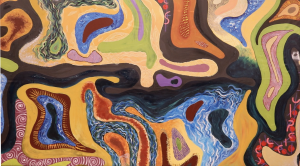
The finished artwork: After the 7 hour collaborative session the artwork was finalised
COVID-19 has forced many events to be postponed, including the annual National NAIDOC Week usually celebrated in July. While the official week of events has been moved to November, Deakin staff found an innovative way to virtually mark NAIDOC Week and celebrate Indigenous culture while connecting community from across Australia.
On Thursday 9 July, Deakin’s National Indigenous Knowledges Education Research Innovation (NIKERI) Institute hosted a seven-hour live Zoom art session that resulted in a collaborative mural. Local, international and interstate participants were able to drop in and out of the durational session, and share their own history, memories and stories to be interpreted by artists Kiri Wicks (Partnerships Coordinator for NIKERI Institute) and Dr Jenny Murray-Jones (Visual Arts Co-ordinator and Lecturer, NIKERI Institute) using paint.
Kiri chats more about the concept and how the event unfolded.
How did the idea come about?
Diversity and Inclusion Partnerships Officer, Adam Carter, and Indigenous Inclusion Coordinator, Tom Molyneux, and myself had actually been talking about the idea of a large scale mural pre-COVID. We wanted it to be a collaborative artwork, that represented the three of us but also the diverse communities we signify.
With NAIDOC week postponed this year and the ‘black lives matter’ movement front of mind, many people are feeling displaced, isolated and disconnected. We really wanted a way to connect with others, and to celebrate community, heritage and Country.
What did the project achieve?
The live art project was a contemporary interpretation of traditional Indigenous painting and oral storytelling. Offering a visual representation and recording of conversations and stories, it was a way for people to take pride in their knowledges and demonstrate their love of Country.
How many people tuned in and contributed?
We had 55 people register for the live art Zoom session. Some people tuned in and stayed for just a few minutes or an hour, while others actually stayed online for the entire seven-hour session.
It was fantastic to see such a diverse audience take interest in the project. There were non-indigenous and Indigenous Australians, and national and international peoples – one person even told stories about forests in North America! Moving the project online offered an opportunity to connect with people we otherwise might not have.
What kinds of stories did people share?
People shared their stories of learning, and of their language, region and history. One person even talked about the graffiti in Fitzroy – it was a nice reminder that beneath all of that city concrete, there’s also a wealth of culture that we often forget.
One of my favourite aspects of the live art session was listening to Tom commentate. He shared his extensive knowledge, stories and photos, and it was a real learning experience for everyone involved.
How did you find the experience of representing other people’s stories?
It’s certainly both a privilege and a responsibility to put other people’s thoughts and memories on canvas. It’s a challenge to create an abstract and simplified version of their story using paint, and a lot of it comes down to the correct colour selection. When people were telling their stories, it was often a description of the land, and it was important to honour the colours of their respective areas – whether it’s the colour of moss next to a lake, or the red dirt of a desert. We would ask them to describe the colours and the landscape, and then perform research using our iPhones.It was truly collaborative. People told their own story, but the artist and commentators put their own lens – their own interpretation – on the narrative too. It was interesting to see different people come together and find comparisons, or to hear how two people experienced the same place in completely different ways.
When we finished the painting, we shared the final mural with the participants. It was really satisfying to see them recognise their own patch of story within its borders.
What will happen to the final product now?
The painting is currently hanging in the NIKERI Institute and this will be its home. But the painting was a whole-community project, so we would love to see it eventually travel between all of Deakin’s campuses.